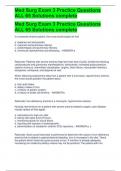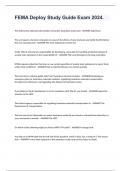Med Surg Exam 3 Practice Questions
ALL 65 Solutions complete
Med Surg Exam 3 Practice Questions
ALL 65 Solutions complete
In a severely anemic patient, the nurse would expect to find
a. dyspnea and tachycardia.
b. cyanosis and pulmonary edema.
c. cardiomegaly and pulmonary fibrosis.
d. ventricular dysrhythmias and wheezing. - ANSWER-a
Rationale: Patients with severe anemia (Hgb level less than 6 g/dL) exhibit the following
cardiovascular and pulmonary manifestations: tachycardia, increased pulse pressure,
systolic murmurs, intermittent claudication, angina, heart failure, myocardial infarction,
tachypnea, orthopnea, and dyspnea at rest.
When obtaining assessment data from a patient with a microcytic, hypochromic anemia,
the nurse would question the patient about
a. folic acid intake.
b. dietary intake of iron.
c. a history of gastric surgery.
d. a history of sickle cell anemia. - ANSWER-b
Rationale: Iron-deficiency anemia is a microcytic, hypochromic anemia.
Nursing interventions for a patient with severe anemia related to peptic ulcer disease
include (select all that apply)
a. instructions for high-iron diet.
b. taking vital signs every 8 hours.
c. monitoring stools for occult blood.
d. teaching self-injection of erythropoietin.
e. administration of cobalamin (vitamin B12) injections. - ANSWER-a, c
Rationale: Stool occult blood test is performed to determine the cause of iron-deficiency
anemia that is related to gastrointestinal bleeding. Iron is increased in the diet. Teach
the patient which foods are good sources of iron. If nutrition is already adequate,
increasing iron intake by dietary means may not be practical. The patient with iron
,Med Surg Exam 3 Practice Questions
ALL 65 Solutions complete
deficiency related to acute blood loss may require a transfusion of packed red blood
cells (RBCs).
The nursing management of a patient in sickle cell crisis includes (select all that apply)
a. monitoring CBC.
b. optimal pain management and O2 therapy.
c. blood transfusions if required and iron chelation.
d. rest as needed and deep vein thrombosis prophylaxis.
e. administration of IV iron and diet high in iron content. - ANSWER-a, b, c, d
Rationale: Complete blood count (CBC) is monitored. Infections are common with
elevated WBC counts, and anemia may occur with low hemoglobin levels and low RBC
counts. O2 may be administered to treat hypoxia and control sickling. Rest may be
instituted to reduce metabolic requirements, and prophylaxis for deep vein thrombosis
(with anticoagulants) is prescribed. Transfusion therapy is indicated when an aplastic
crisis occurs. Patients may require iron chelation therapy to reduce transfusion-
produced iron overload. Pain occurring during an acute crisis is usually undertreated;
patients should have optimal pain control with opioid analgesics, nonsteroidal
antiinflammatory agents, antineuropathic pain medications, local anesthetics, or nerve
blocks.
A complication of the hyperviscosity of polycythemia is
a. thrombosis.
b. cardiomyopathy.
c. pulmonary edema.
d. disseminated intravascular coagulation (DIC). - ANSWER-a
Rationale: The patient with polycythemia may experience angina, heart failure,
intermittent claudication, and thrombophlebitis, which may be complicated by
embolization. These manifestations are caused by blood vessel distention, impaired
blood flow, circulatory stasis, thrombosis, and tissue hypoxia, which is caused by the
hypervolemia and hyperviscosity. The most common serious acute complication is
stroke, caused by thrombosis.
When caring for a patient with thrombocytopenia, the nurse instructs the patient to
a. dab his or her nose instead of blowing.
b. be careful when shaving with a safety razor.
c. continue with physical activities to stimulate thrombopoiesis.
, Med Surg Exam 3 Practice Questions
ALL 65 Solutions complete
d. avoid aspirin because it may mask the fever that occurs with thrombocytopenia. -
ANSWER-a
Rationale: Patients with thrombocytopenia should avoid aspirin because it reduces
platelet adhesiveness, which contributes to bleeding. Patients should not perform
vigorous exercise or lift weights. If a patient is weak and at risk for falling, supervise the
patient when he or she is out of bed. Blowing the nose forcefully should be avoided. The
patient should gently pat the nose with a tissue if needed. Instruct patients not to shave
with a blade; an electric razor should be used.
The nurse would anticipate that a patient with von Willebrand disease undergoing
surgery would be treated with administration of vWF and
a. thrombin.
b. factor VI.
c. factor VII.
d. factor VIII. - ANSWER-d
Rationale: von Willebrand disease involves deficiency of the von Willebrand coagulation
protein, variable factor VIII deficiencies, and platelet dysfunction. Treatment includes
administration of von Willebrand factor and factor VIII.
DIC is a disorder in which
a. the coagulation pathway is genetically altered, leading to thrombus formation in all
major blood vessels.
b. an underlying disease depletes hemolytic factors in the blood, leading to diffuse
thrombotic episodes and infarcts.
c. a disease process stimulates coagulation processes with resultant thrombosis, as
well as depletion of clotting factors, leading to diffuse clotting and hemorrhage.
d. an inherited predisposition causes a deficiency of clotting factors that leads to
overstimulation of coagulation processes in the vasculature. - ANSWER-c
Rationale: In disseminated intravascular coagulation (DIC), the coagulation process is
stimulated, with resultant thrombosis and depletion of clotting factors, which leads to
diffuse clotting and hemorrhage. The paradox of this condition is characterized by the
profuse bleeding that results from the depletion of platelets and clotting factors.
Priority nursing actions when caring for a hospitalized patient with a new-onset
temperature of 102.2° F (39° C) and severe neutropenia include (select all that apply)





